Cloud Technology and Fundamentals: Securing Cloud Data and Encryption
VerifiedAdded on 2022/09/07
|5
|1198
|18
Homework Assignment
AI Summary
This assignment delves into the critical aspects of cloud data security. It begins by highlighting the significance of securing sensitive data stored in cloud environments, addressing threats like data breaches. The solution outlines key measures, including encryption techniques such as public key and symmetric encryption, and authentication methods like token authentication and multi-factor authentication to ensure data confidentiality, integrity, and availability. It explains full disk encryption (FDE) for data-at-rest and end-to-end encryption for data-in-transit. Additionally, the assignment discusses the role of cloud firewalls in filtering unwanted network traffic and mitigating attacks like DDoS, emphasizing their importance in maintaining strong communication and overall business operations. The provided references further support the concepts discussed.
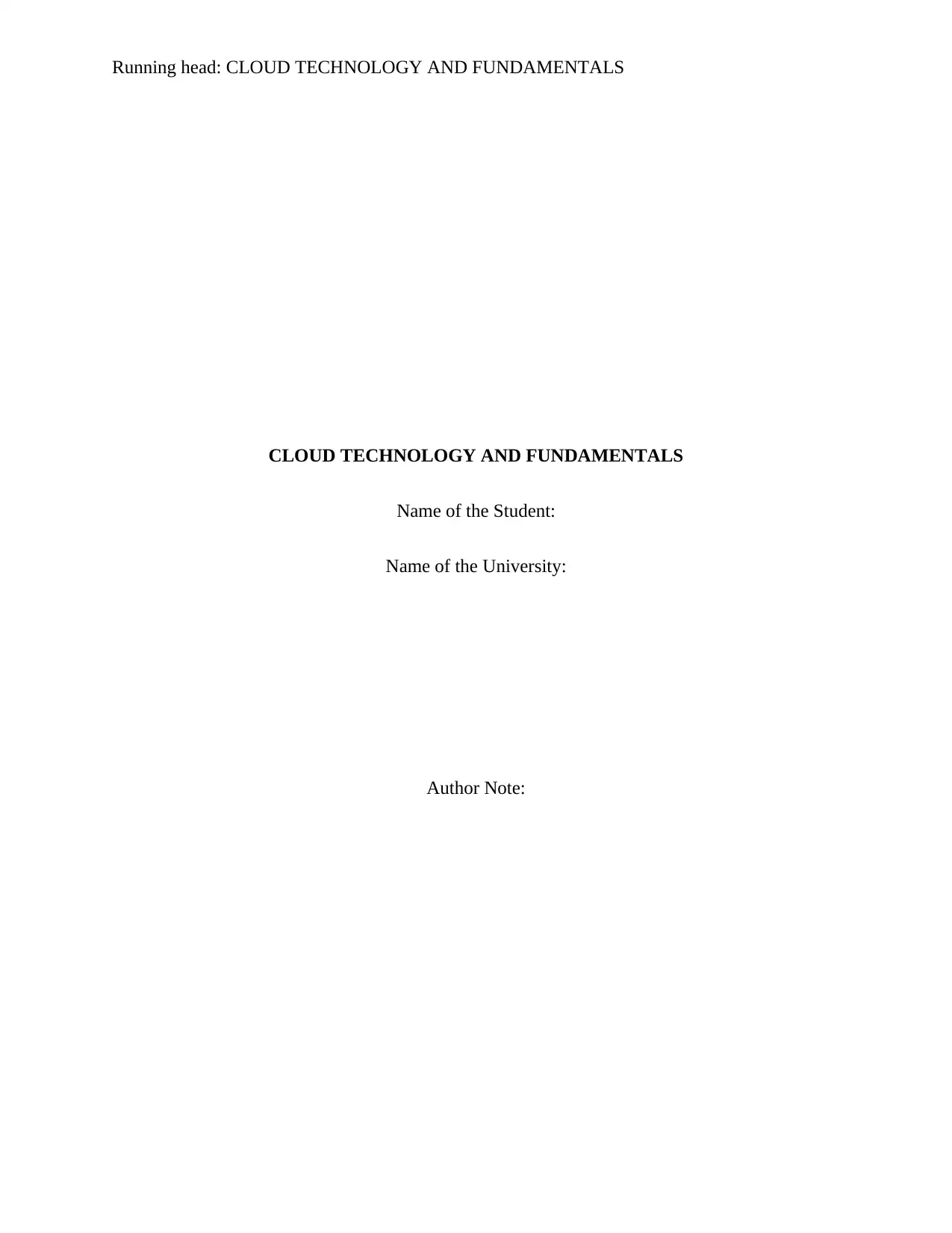
Running head: CLOUD TECHNOLOGY AND FUNDAMENTALS
CLOUD TECHNOLOGY AND FUNDAMENTALS
Name of the Student:
Name of the University:
Author Note:
CLOUD TECHNOLOGY AND FUNDAMENTALS
Name of the Student:
Name of the University:
Author Note:
Paraphrase This Document
Need a fresh take? Get an instant paraphrase of this document with our AI Paraphraser
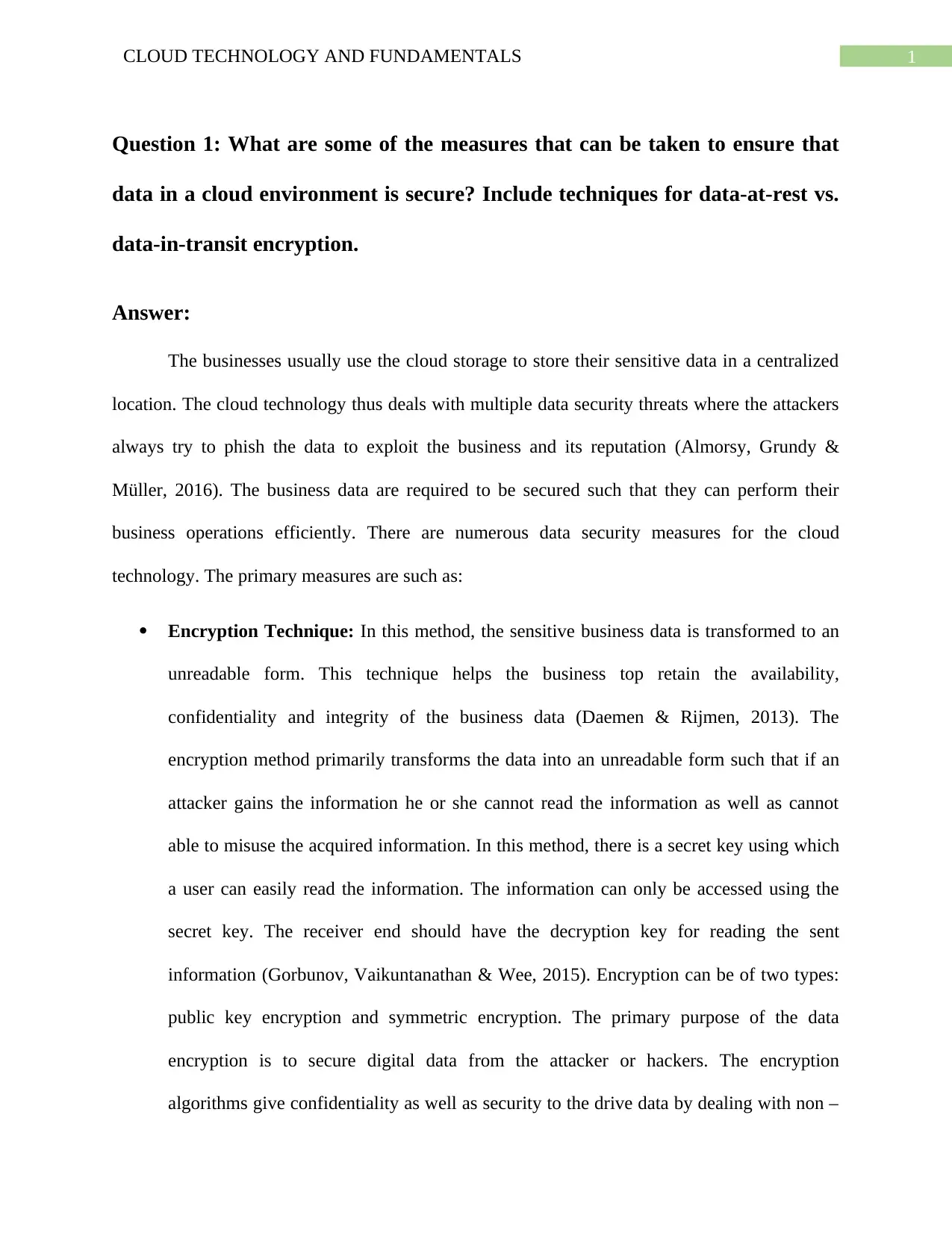
1CLOUD TECHNOLOGY AND FUNDAMENTALS
Question 1: What are some of the measures that can be taken to ensure that
data in a cloud environment is secure? Include techniques for data-at-rest vs.
data-in-transit encryption.
Answer:
The businesses usually use the cloud storage to store their sensitive data in a centralized
location. The cloud technology thus deals with multiple data security threats where the attackers
always try to phish the data to exploit the business and its reputation (Almorsy, Grundy &
Müller, 2016). The business data are required to be secured such that they can perform their
business operations efficiently. There are numerous data security measures for the cloud
technology. The primary measures are such as:
Encryption Technique: In this method, the sensitive business data is transformed to an
unreadable form. This technique helps the business top retain the availability,
confidentiality and integrity of the business data (Daemen & Rijmen, 2013). The
encryption method primarily transforms the data into an unreadable form such that if an
attacker gains the information he or she cannot read the information as well as cannot
able to misuse the acquired information. In this method, there is a secret key using which
a user can easily read the information. The information can only be accessed using the
secret key. The receiver end should have the decryption key for reading the sent
information (Gorbunov, Vaikuntanathan & Wee, 2015). Encryption can be of two types:
public key encryption and symmetric encryption. The primary purpose of the data
encryption is to secure digital data from the attacker or hackers. The encryption
algorithms give confidentiality as well as security to the drive data by dealing with non –
Question 1: What are some of the measures that can be taken to ensure that
data in a cloud environment is secure? Include techniques for data-at-rest vs.
data-in-transit encryption.
Answer:
The businesses usually use the cloud storage to store their sensitive data in a centralized
location. The cloud technology thus deals with multiple data security threats where the attackers
always try to phish the data to exploit the business and its reputation (Almorsy, Grundy &
Müller, 2016). The business data are required to be secured such that they can perform their
business operations efficiently. There are numerous data security measures for the cloud
technology. The primary measures are such as:
Encryption Technique: In this method, the sensitive business data is transformed to an
unreadable form. This technique helps the business top retain the availability,
confidentiality and integrity of the business data (Daemen & Rijmen, 2013). The
encryption method primarily transforms the data into an unreadable form such that if an
attacker gains the information he or she cannot read the information as well as cannot
able to misuse the acquired information. In this method, there is a secret key using which
a user can easily read the information. The information can only be accessed using the
secret key. The receiver end should have the decryption key for reading the sent
information (Gorbunov, Vaikuntanathan & Wee, 2015). Encryption can be of two types:
public key encryption and symmetric encryption. The primary purpose of the data
encryption is to secure digital data from the attacker or hackers. The encryption
algorithms give confidentiality as well as security to the drive data by dealing with non –
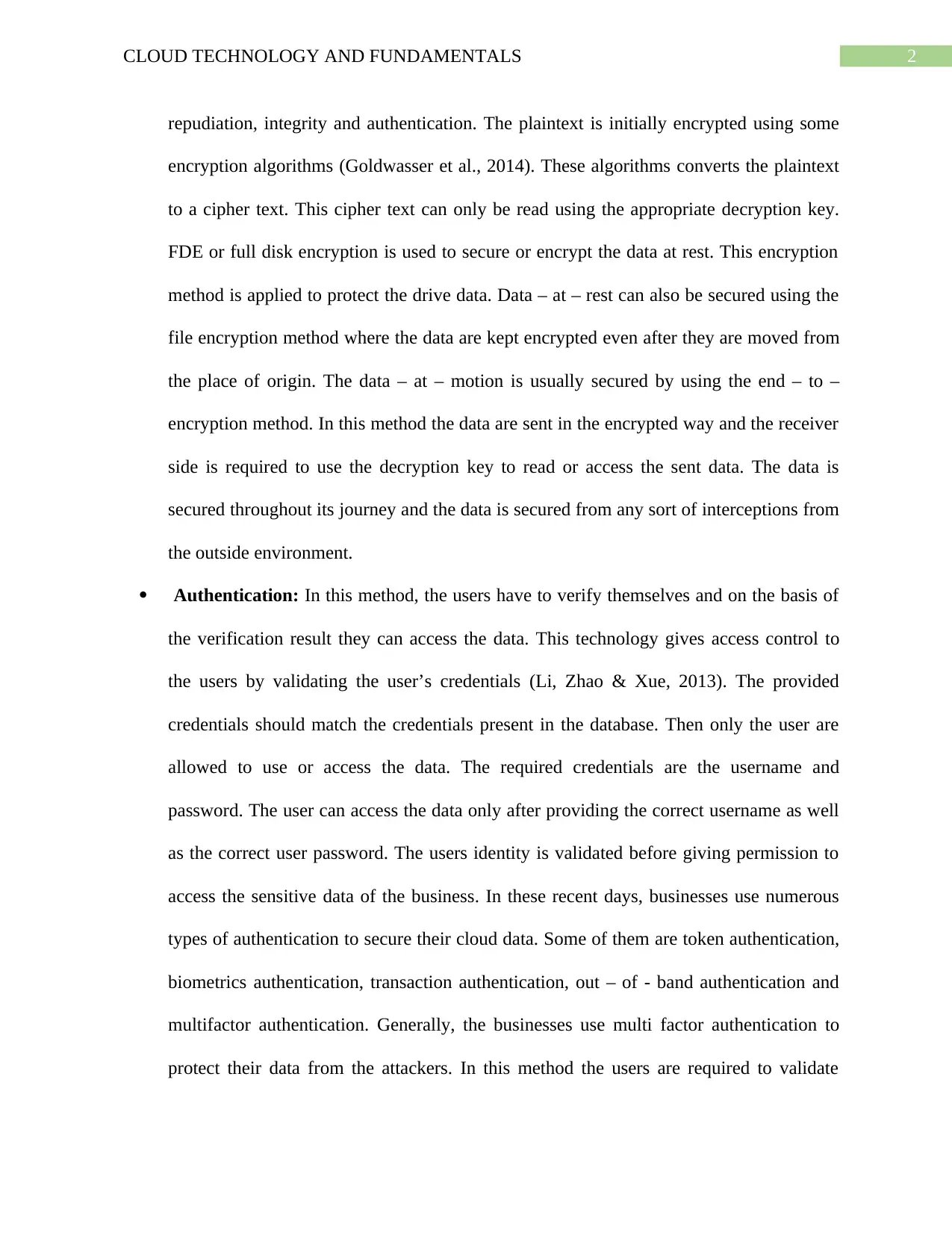
2CLOUD TECHNOLOGY AND FUNDAMENTALS
repudiation, integrity and authentication. The plaintext is initially encrypted using some
encryption algorithms (Goldwasser et al., 2014). These algorithms converts the plaintext
to a cipher text. This cipher text can only be read using the appropriate decryption key.
FDE or full disk encryption is used to secure or encrypt the data at rest. This encryption
method is applied to protect the drive data. Data – at – rest can also be secured using the
file encryption method where the data are kept encrypted even after they are moved from
the place of origin. The data – at – motion is usually secured by using the end – to –
encryption method. In this method the data are sent in the encrypted way and the receiver
side is required to use the decryption key to read or access the sent data. The data is
secured throughout its journey and the data is secured from any sort of interceptions from
the outside environment.
Authentication: In this method, the users have to verify themselves and on the basis of
the verification result they can access the data. This technology gives access control to
the users by validating the user’s credentials (Li, Zhao & Xue, 2013). The provided
credentials should match the credentials present in the database. Then only the user are
allowed to use or access the data. The required credentials are the username and
password. The user can access the data only after providing the correct username as well
as the correct user password. The users identity is validated before giving permission to
access the sensitive data of the business. In these recent days, businesses use numerous
types of authentication to secure their cloud data. Some of them are token authentication,
biometrics authentication, transaction authentication, out – of - band authentication and
multifactor authentication. Generally, the businesses use multi factor authentication to
protect their data from the attackers. In this method the users are required to validate
repudiation, integrity and authentication. The plaintext is initially encrypted using some
encryption algorithms (Goldwasser et al., 2014). These algorithms converts the plaintext
to a cipher text. This cipher text can only be read using the appropriate decryption key.
FDE or full disk encryption is used to secure or encrypt the data at rest. This encryption
method is applied to protect the drive data. Data – at – rest can also be secured using the
file encryption method where the data are kept encrypted even after they are moved from
the place of origin. The data – at – motion is usually secured by using the end – to –
encryption method. In this method the data are sent in the encrypted way and the receiver
side is required to use the decryption key to read or access the sent data. The data is
secured throughout its journey and the data is secured from any sort of interceptions from
the outside environment.
Authentication: In this method, the users have to verify themselves and on the basis of
the verification result they can access the data. This technology gives access control to
the users by validating the user’s credentials (Li, Zhao & Xue, 2013). The provided
credentials should match the credentials present in the database. Then only the user are
allowed to use or access the data. The required credentials are the username and
password. The user can access the data only after providing the correct username as well
as the correct user password. The users identity is validated before giving permission to
access the sensitive data of the business. In these recent days, businesses use numerous
types of authentication to secure their cloud data. Some of them are token authentication,
biometrics authentication, transaction authentication, out – of - band authentication and
multifactor authentication. Generally, the businesses use multi factor authentication to
protect their data from the attackers. In this method the users are required to validate
⊘ This is a preview!⊘
Do you want full access?
Subscribe today to unlock all pages.

Trusted by 1+ million students worldwide
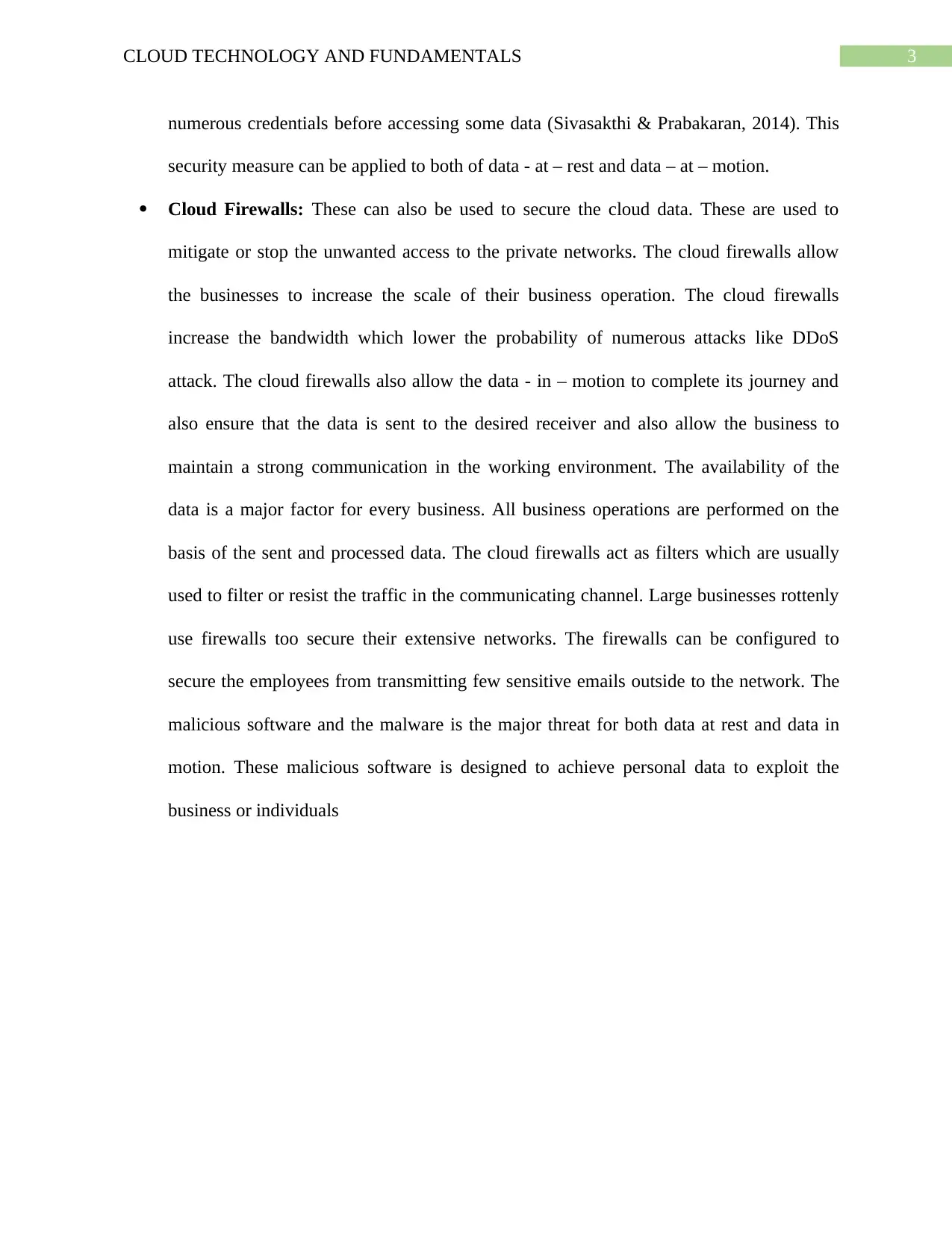
3CLOUD TECHNOLOGY AND FUNDAMENTALS
numerous credentials before accessing some data (Sivasakthi & Prabakaran, 2014). This
security measure can be applied to both of data - at – rest and data – at – motion.
Cloud Firewalls: These can also be used to secure the cloud data. These are used to
mitigate or stop the unwanted access to the private networks. The cloud firewalls allow
the businesses to increase the scale of their business operation. The cloud firewalls
increase the bandwidth which lower the probability of numerous attacks like DDoS
attack. The cloud firewalls also allow the data - in – motion to complete its journey and
also ensure that the data is sent to the desired receiver and also allow the business to
maintain a strong communication in the working environment. The availability of the
data is a major factor for every business. All business operations are performed on the
basis of the sent and processed data. The cloud firewalls act as filters which are usually
used to filter or resist the traffic in the communicating channel. Large businesses rottenly
use firewalls too secure their extensive networks. The firewalls can be configured to
secure the employees from transmitting few sensitive emails outside to the network. The
malicious software and the malware is the major threat for both data at rest and data in
motion. These malicious software is designed to achieve personal data to exploit the
business or individuals
numerous credentials before accessing some data (Sivasakthi & Prabakaran, 2014). This
security measure can be applied to both of data - at – rest and data – at – motion.
Cloud Firewalls: These can also be used to secure the cloud data. These are used to
mitigate or stop the unwanted access to the private networks. The cloud firewalls allow
the businesses to increase the scale of their business operation. The cloud firewalls
increase the bandwidth which lower the probability of numerous attacks like DDoS
attack. The cloud firewalls also allow the data - in – motion to complete its journey and
also ensure that the data is sent to the desired receiver and also allow the business to
maintain a strong communication in the working environment. The availability of the
data is a major factor for every business. All business operations are performed on the
basis of the sent and processed data. The cloud firewalls act as filters which are usually
used to filter or resist the traffic in the communicating channel. Large businesses rottenly
use firewalls too secure their extensive networks. The firewalls can be configured to
secure the employees from transmitting few sensitive emails outside to the network. The
malicious software and the malware is the major threat for both data at rest and data in
motion. These malicious software is designed to achieve personal data to exploit the
business or individuals
Paraphrase This Document
Need a fresh take? Get an instant paraphrase of this document with our AI Paraphraser
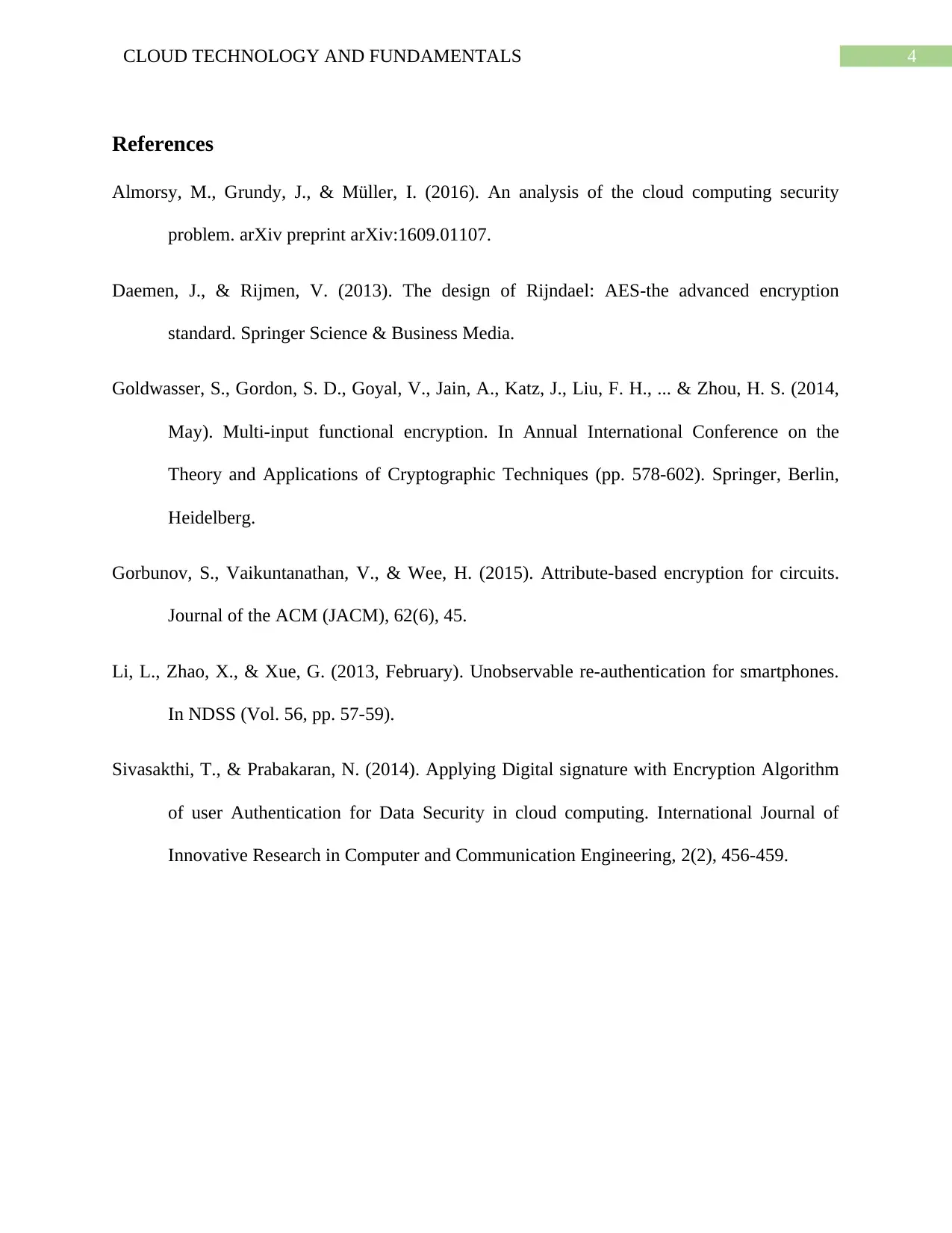
4CLOUD TECHNOLOGY AND FUNDAMENTALS
References
Almorsy, M., Grundy, J., & Müller, I. (2016). An analysis of the cloud computing security
problem. arXiv preprint arXiv:1609.01107.
Daemen, J., & Rijmen, V. (2013). The design of Rijndael: AES-the advanced encryption
standard. Springer Science & Business Media.
Goldwasser, S., Gordon, S. D., Goyal, V., Jain, A., Katz, J., Liu, F. H., ... & Zhou, H. S. (2014,
May). Multi-input functional encryption. In Annual International Conference on the
Theory and Applications of Cryptographic Techniques (pp. 578-602). Springer, Berlin,
Heidelberg.
Gorbunov, S., Vaikuntanathan, V., & Wee, H. (2015). Attribute-based encryption for circuits.
Journal of the ACM (JACM), 62(6), 45.
Li, L., Zhao, X., & Xue, G. (2013, February). Unobservable re-authentication for smartphones.
In NDSS (Vol. 56, pp. 57-59).
Sivasakthi, T., & Prabakaran, N. (2014). Applying Digital signature with Encryption Algorithm
of user Authentication for Data Security in cloud computing. International Journal of
Innovative Research in Computer and Communication Engineering, 2(2), 456-459.
References
Almorsy, M., Grundy, J., & Müller, I. (2016). An analysis of the cloud computing security
problem. arXiv preprint arXiv:1609.01107.
Daemen, J., & Rijmen, V. (2013). The design of Rijndael: AES-the advanced encryption
standard. Springer Science & Business Media.
Goldwasser, S., Gordon, S. D., Goyal, V., Jain, A., Katz, J., Liu, F. H., ... & Zhou, H. S. (2014,
May). Multi-input functional encryption. In Annual International Conference on the
Theory and Applications of Cryptographic Techniques (pp. 578-602). Springer, Berlin,
Heidelberg.
Gorbunov, S., Vaikuntanathan, V., & Wee, H. (2015). Attribute-based encryption for circuits.
Journal of the ACM (JACM), 62(6), 45.
Li, L., Zhao, X., & Xue, G. (2013, February). Unobservable re-authentication for smartphones.
In NDSS (Vol. 56, pp. 57-59).
Sivasakthi, T., & Prabakaran, N. (2014). Applying Digital signature with Encryption Algorithm
of user Authentication for Data Security in cloud computing. International Journal of
Innovative Research in Computer and Communication Engineering, 2(2), 456-459.
1 out of 5
Related Documents
Your All-in-One AI-Powered Toolkit for Academic Success.
+13062052269
info@desklib.com
Available 24*7 on WhatsApp / Email
![[object Object]](/_next/static/media/star-bottom.7253800d.svg)
Unlock your academic potential
Copyright © 2020–2025 A2Z Services. All Rights Reserved. Developed and managed by ZUCOL.





